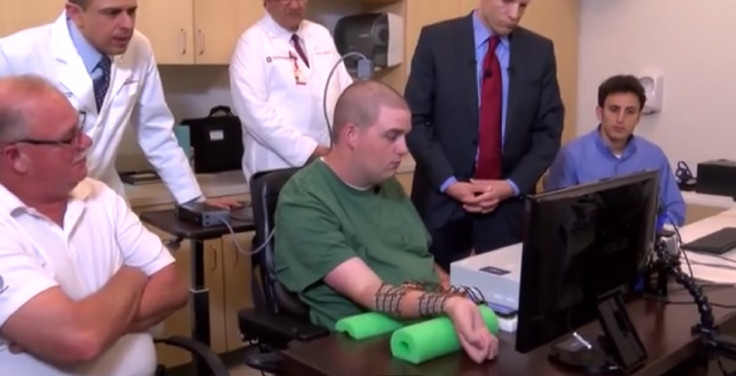Power of Thought: Quadriplegic Ohio Man Ian Burkhart First to Use Mind to Move Hand

A 23-year-old quadriplegic man from the US has become the first patient to move his hand and fingers using just his own thoughts.
Ian Burkhart, who was paralysed in a diving accident, was able to open and close his fist after doctors inserted a microchip in his brain.
He was even able to pick up a spoon during initial tests of the chip, giving hope to millions of accident victims and sufferers of strokes worldwide.
Burkhart is the first quadriplegic to use Neurobridge technology, created by Ohio State University Wexner Medical Center, an electronic neural system that bypasses spinal cord injuries to transmit instructions directly from the brain to the muscles.
"It's much like a heart bypass, but instead of bypassing blood, we're actually bypassing electrical signals," said research leader Chad Bouton, as reported in the Independent. "We're taking those signals from the brain, going around the injury, and actually going directly to the muscles."
Four years ago, Burkhart was paralysed from the chest down during a trip to the beach. He dived into a submerged sandbar on the North Carolina coast, breaking his neck.
Prior to his accident, he had been a keen lacrosse player. Determined to continue living life, Burkhart went on to complete a college degree, while coaching his old high school lacrosse team to the state championship finals.
"I'd say that the thing I miss most is just being independent," Burkhart said in April, shortly before doctors implanted a chip in his brain.
"It would really be nice to just do something as simple as open up a water bottle myself," he told the Washington Post.
He underwent surgery in April to implant the 0.15 inch wide chip into his brain, which has 96 electrodes that "read" what he is thinking.
Burkhart had weeks of practice sessions, during which he focused on moving his fingers, while the chip responded by moving an animated hand on a computer screen.
The technology allows signals sent by the computer to triggered electrodes in the sleeve which stimulated the hand muscles, causing them to move as if a message had been sent directly by the brain.
On his first attempt, he was able to curl his hand into a fist, open it out and pick up a spoon.
Speaking to CBS News afterwards, Burkhart said: "Physically, it was a foreign feeling. Emotionally it was definitely a sense of hope and excitement to know that it's possible."
Dr Ali Rezai, Mr Burkhart's surgeon, said: "I do believe there will be a day coming soon when somebody who's got a disability – being a quadriplegic or somebody with a stroke, somebody with any kind of brain injury – can use the power of their mind and by thinking, be able to move their arms or legs."
© Copyright IBTimes 2025. All rights reserved.






















